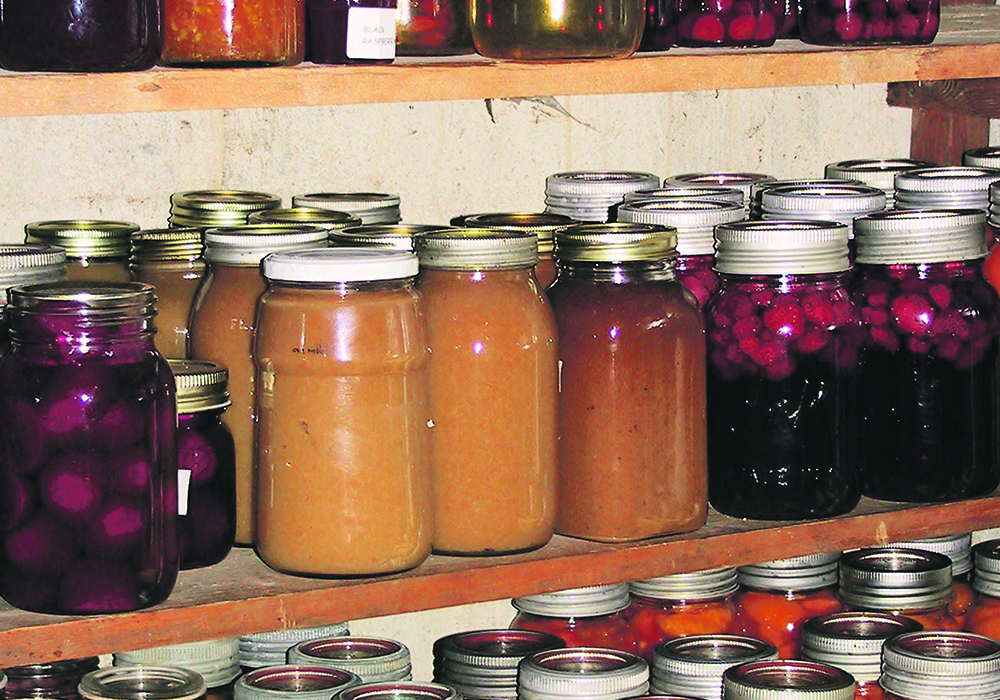A stash of old sealers helps preserve memories of an art that has been passed from grandmother to mother to daughter
It was a weathered old wooden box with a slant lid. To get to it, we had to cut a trail as far as we could go with the lawn mower, then resort to the scythe, and finally the hatchet. Before we could open the lid, the lower limbs of a gnarled maple tree had to be pruned.
The rusty hinges on the old box creaked in protest as I raised the lid. Lifting out the stacks of yellowed newspapers, I made a discovery.
The box was filled with old preserving jars — dozens of sealers buried underneath layers of old newsprint.
Read Also

Environmental farm group has Ottawa’s attention
In 2021, Farmers for Climate Solutions published a report on how Canada should reduce emissions from agriculture. Not long after, the federal government implemented most of the recommendations in the report.
That afternoon I washed dust and straw and cobwebs from dozens of sealers until they were sparkling clean. That old box proved to be a treasure chest, even containing Gems and Jewels — trade names embossed on the glass jars.
Over the years, I inherited more sealers to add to my stash, and preserving time becomes a family gathering of memories. My mind trails off to the various farm women down through the decades whose hands have also prepared these sealers for food storage. Such memories are a thread of continuity connecting one generation to the next, reminding me of people and preferences I loved and respected.
The half-gallon jars originally belonged to my mother-in-law, where they sat on sagging shelves in the basement of her old Saskatchewan farm house. Every year, they were emptied of canned goose meat and creamed corn and tomato juice to help feed a family of nine.
Many of the quart jars were once my maternal grandmother’s and she filled them with the wild fruit she picked along the edge of the pasture —saskatoons and highbush cranberries and wild plums — always wild plums, in rich heavy syrup the way Grandpa liked them.
Then it was my mother’s turn and she filled the quart jars with chili sauce and rhubarb and canned pork.
Thanks to these old sealers, every autumn I walk down memory lane and husk the corn in a homesteader’s garden in Saskatchewan or gather wild plums with Grandma on a sand knoll in Manitoba or pick ripe tomatoes in Mom’s garden.
Considering all the people who have toted these same preserving jars up and down basement steps with all their inherent hazards, it’s amazing that the jars have outlasted the people to whom they once belonged. And yet some of these jars with the blue-green tinge date back almost a 100 years to my maternal grandmother.
The cellar steps, I vaguely remember in her old homestead, were more like a ladder. Crudely nailed together out of poplar poles, they provided access into the dugout cellar through a trapdoor in the kitchen floor.
Although not extending down from a trap door, the stairs in my childhood home were not exceptionally sturdy either, just crude slabs from my Dad’s sawmill. In fall I helped my mother carry the preserves to their place in the far corner of the dirt floor basement. Sent to retrieve a sealer in the middle of winter, my hand sometimes groped through sticky cobwebs draped from jar to jar. It made me think of being trapped in a haunted dungeon.
The earthy smell of the potatoes in their storage bin, and the eerie flames of the wood furnace licking at the burning logs, served only to stoke my active imagination. Dashing up the cellar steps with my jar of preserves I banged the cellar door behind me to keep any imaginary ogres at bay.
On the other hand, some of the jars I have came from Aunt Emma’s fine farmhouse with a stone basement and painted steps. Compared to the dark, dreary dugouts to which I was accustomed, her basement actually had an electric light bulb that hung from a twisted cord, making it ever so much easier to tell the difference between a jar of pickled beets and a sealer of prune plums.
On hot, muggy days, I would have been perfectly content to play in that nice, cool basement, except for the fact that one or two lizards sometimes had the same idea, and I was absolutely, positively petrified of lizards. Had I ever discovered one near the fruit cupboard, I would have promptly dropped even the choicest jar of preserves and fled for my life back up those painted steps.
But now I am safely at the bottom of my own carpeted stairs. I switch on the fluorescent light and scan the jars of preserves on my pantry shelves. Our oldest grandson is coming for lunch, you see. He wants to learn how to preserve peaches and raspberries and pickles and….
I wonder, in time, what sort of memories these sealers will evoke for him?















